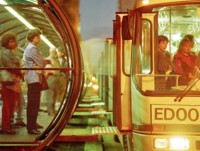Cities setting standards in eco-innovation - Curitiba, Brazil

Curitiba is Brazil’s seventh largest city and ‘green
capital’. One of the best examples of green urban planning, it
shows a city can minimise its environmental impact and be
attractive.
Eco-innovation is usually applied to products, not cities. Yet the
planning achievements of Curitiba and other cities can indeed be
considered eco- innovations. Most people today live in urban areas,
and this migration is set to continue. Local authorities are
confronted with the harsh realities of environmental problems as
the environmental footprints of cities rise.
Also inhabitants are concerned about air pollution, congestion,
dirty water and waste, so authorities are pressed to innovate to
deliver greener, cleaner, more pleasant places to live. Quality of
the environment is also becoming an important element of the
attractiveness of cities as locations for new business and
investments.
Getting it right from the start
Some, such as Curitiba and the Dongtan district planned for
outside Shanghai, China, are getting it right from the start. In
the 1970s, when Brazil was welcoming industry with open arms,
Curitiba only allowed non- polluters to settle within its limits
and built an industrial district with big green spaces. Some
sniggered, until its growth outstripped that of its more polluted
neighbours.
Today, the city provides about 52 m2 of green space for
every inhabitant, up from 1 m2 in 1970. Environmental
legislation protects the local vegetation of mixed subtropical
forest, which has been threatened by urban development. Some 70% of
all waste is recycled.
Public transport is organised in the form of concentric circles
of local bus lines that connect up to five big bus lines radiating
out from the city centre in a spider web pattern. Commercial
development is encouraged along these main arteries, reducing
pressure on the city centre, which has been part
pedestrianised.
Moreover, the closer a building is to a transport route, the
more offices or people it must house for maximum transport
efficiency. Buses stop at elevated transparent plastic tube
stations with entry at one end and exit at the other, and
passengers pay a fixed fare before boarding to further speed things
up. This highly efficient system has inspired others, from Bogota
in Colombia to Los Angeles in the USA to Kuala Lumpur in
Malaysia.
Two additional things Curitiba has done right, according to
green innovation experts is thinking about looks as well as
efficiency. It is a comfortable, well thought-out city, not just an
efficient one. Too often eco-innovations are still promoted largely
on their environmental rather than wider merits.
Making the most of local resources
Another city with a master plan is Helsinki. This is the world’s
first city with a comprehensive plan for under the ground. The
city’s geology of hard bedrock located shallowly enough to be
usable makes this possible. So, the city can expand while avoiding
urban sprawl.
There are thousands of structures underground, including some
60 km of underground pipelines that together constitute a
comprehensive district heating and cooling network. Even an
underground data centre feeds its excess heat into this.
An alternative example of innovative planning and use of local
resources is the Lieberose solar energy project in former eastern
Germany. One of the world’s largest photovoltaic solar parks has
been built on a former military training ground. By leasing the
land to the project, the regional government of Brandenburg could
pay for its decontamination.
Today, 750 000 thin film solar panels provide 15 000
households with clean electricity. In 2029, when the park is due to
be dismantled and its panels recycled, the area will revert to a
natural meadow.
Getting the infrastructure right
Adaptation to climate change is triggering a rethink of city
planning policies in many cases, whether because the natural
surroundings are expected to change - such as rising seawater
levels for coastal cities - or because renewable energies need to
be built and connected to the grid as is the case with unsightly
wind turbines. Obtaining planning permission remains one of the key
obstacles to renewables development across Europe.
A related issue is transport. With congestion on the streets,
oil prices rising and transport’s carbon emissions continuing to
increase, even as other sectors’ drop, there are plans for a new
infrastructure from more public transport to car sharing to
electric cars.
The City of Burgos in Spain for one has overhauled its transport
infrastructure. Its approach has centred on improving public
transport, turning the city centre into a pedestrian zone and
promoting bikes and car sharing.
Three-quarters of its buses now run on biodiesel, routes have
been changed for greater efficiency, and bus use has increased by
8%. A 4-km2 area in the city centre has been turned into a car-free
zone and a new traffic control centre provides real-time advice to
drivers about where to park and how to avoid traffic. A free
bicycle rental scheme with 16 hire points acquired 5 000 users
after three years.
Cities are mapping out a sustainable future. Not all had the
luck of having a master architect as Curitiba did to get them off
to a flying start. But they are drawing inspiration from one
another through countless knowledge- sharing networks and, more
importantly, necessity is driving innovation. City planners are
turning environmental problems into opportunities.
This article was originally published in
target=”_blank”>ETAP, a publication of the Environment
Directorate of the European Commission
Source: ec.europa.eu

